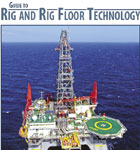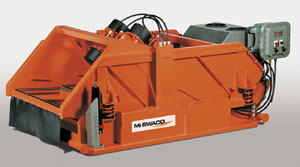Rig floor equipment: New dual-motion shale shaker
December 2004 Supplement Rig Floor Equipment New dual-motion shale sha
New dual-motion shale shakerM-I SWACO has introduced its linear and dual-motion Mongoose PT shaker, which is engineered to save rig time by successfully handling cuttings loads generated by high rates of penetration. The dual-motion shaker operates in linear motion to manage high cuttings volumes associated with surface-hole intervals. It can then be changed “on the fly” to balanced-elliptical motion for longer cuttings retention as the well progresses. In the gentler balanced-elliptical mode, solids encounter reduced G-forces and longer screen residence time, resulting in drier solids, improved drilling fluid recovery, longer screen life and reduced operating costs.
Drilled solids are rapidly degraded when processed through solids-control equipment, pumping units and the drillstring. Therefore, it is important to remove such solids from the circulating mud system as soon as possible. Shakers frequently provide the first mechanism of solids removal within the rig’s solids-control package, and have proven to be the simplest and most reliable means of removing large or “coarse” materials from the active mud system. Generally, shale shaker efficiency is determined by its vibration pattern, vibration dynamics, or G-force, deck size and configuration, shaker processing efficiency and shaker screen characteristics. The best solids control requires what once seemed impossible, a shaker that can adapt as solids characteristics change. The BEM-3 shaker, the first with genuine balanced elliptical motion, was a major step in that direction in 1999. The new-generation shaker essentially combines BEM-3 technology with linear motion to create a unit that delivers dual-motion benefits. The new design allows operators to use linear motion while drilling top-hole sections where heavy, high-volume solids such as gumbo are usually encountered, and where shakers need to generate high G-forces to effectively move dense solids across the screens. But as conditions change, a flip of a switch reconfigures motion from linear to balanced elliptical without shutting down the shaker. This motion also allows for higher recovery rates of valuable drilling fluids. From an environmental standpoint, less treatment is required for disposal. And the thorough processing also reduces need for dilution, with smaller waste volumes. The new shaker replaces the typical flowline trap (possum belly) with an innovative distribution box, which increases fluid handling capacity by redirecting flow evenly across the entire screen width. It also dampens fluid velocity from the flowline for more effective solids separation. The unit also accommodates pre-tensioned screens. A reinforced X-frame basket extends screen life by ensuring uniform fluid distribution across the screen and reducing bed fatigue. The ultra-tight seal between screen and screen bed further eliminates solids build-up and costly solids bypass. In an initial field trial, the new shaker processed 790 gpm while running 9.7 lb/gal of water-base fluid over 175-mesh screens, and 720 gpm while running 10.5 lb/gal of oil-base fluid over 210-mesh screens in both linear and balanced elliptical motion. And there were no structural defects of failures after 1,500 hr. |
|||||||||
- Coiled tubing drilling’s role in the energy transition (March 2024)
- Using data to create new completion efficiencies (February 2024)
- Digital tool kit enhances real-time decision-making to improve drilling efficiency and performance (February 2024)
- E&P outside the U.S. maintains a disciplined pace (February 2024)
- U.S. operators reduce activity as crude prices plunge (February 2024)
- Drilling advances (January 2024)
- Applying ultra-deep LWD resistivity technology successfully in a SAGD operation (May 2019)
- Adoption of wireless intelligent completions advances (May 2019)
- Majors double down as takeaway crunch eases (April 2019)
- What’s new in well logging and formation evaluation (April 2019)
- Qualification of a 20,000-psi subsea BOP: A collaborative approach (February 2019)
- ConocoPhillips’ Greg Leveille sees rapid trajectory of technical advancement continuing (February 2019)




